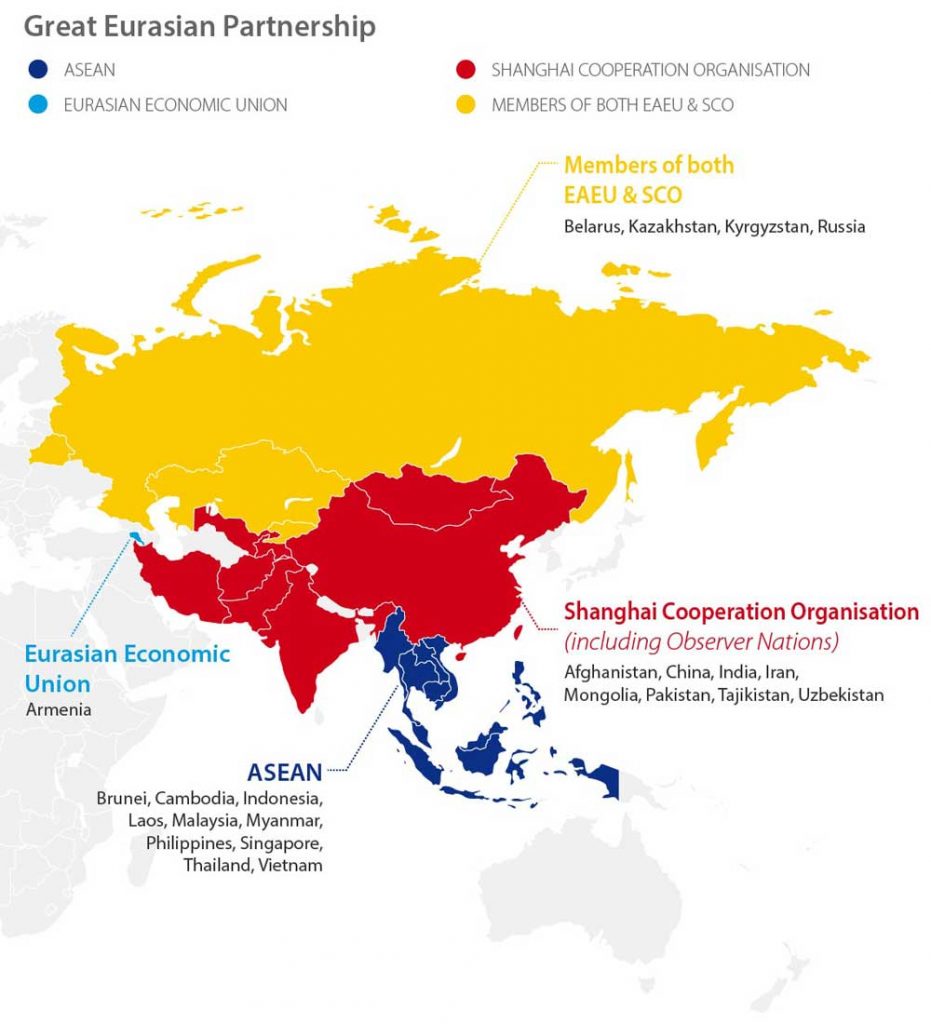The New Eurasian Age – China’s OBOR, The Eurasian Economic Union, and Shanghai Co-Operation Organisation: Complimentary White Paper Download
The coming together of China’s OBOR ambitions with the Russian backed free trade area the Eurasian Economic Union, together with the members of the Shanghai Co-Operation Organisation, is an issue that has been discussed at the highest levels. While China’s OBOR plans have been well discussed, lesser known are the Shanghai Co-Operation Organisation (SCO) and Eurasian Economic Union (EAEU). Yet, both are powerful entities and becoming increasingly so.
The Shanghai Co-Operation Organisation was established at Beijing’s initiative back in 2001, and is a Eurasian political, economic, and security organization. Membership has expanded over the years, and it now includes China, India, Kazakhstan, Kyrgyzstan, Pakistan, Russia, Tajikistan, and Uzbekistan. Afghanistan, Belarus, Iran, and Mongolia are observer nations, with Iran expected to become a full member shortly. Dialogue partners include Armenia, Azerbaijan, Cambodia, Nepal, Sri Lanka, and Turkey.
The SCO’s main function is as a platform for the discussion and resolution of issues affecting the region, including security, political, cultural, and economic development.
The Eurasian Economic Union was formed in 2014 as a free trade bloc, and includes Armenia, Belarus, Kazakhstan, Kyrgyzstan, and Russia. Intended as a Russian answer to the EU, it has an integrated single market of some 183 million people and a GDP of over US$4 trillion (PPP). Multiple nations are currently negotiating Free Trade Agreements with the EAEU, including China, India, and Iran, among others. The implications for Europe, should these be successfully concluded, are immense – it would effectively bring Chinese products right to the border of the European Union
The idea of merging these organizations or at least expanding trade cooperation between them, has been discussed by both China’s President Xi Jinping and Russian President Vladimir Putin. The concept, dubbed the Great Eurasian Partnership could be a global game changer, especially when one considers that it may also include the ASEAN nations – Brunei, Cambodia, Indonesia, Laos, Malaysia, Myanmar, Philippines, Singapore, Thailand, and Vietnam.
The implications are huge, which is why I am pleased to see the publication of an excellent new White Paper report, written by Jeff Schubert, who is a Director of the International Center for Eurasian Research, based in Russia. Jeff’s Report, “The New Eurasian Age: China’s Silk Road and the EAEU in SCO Space” and subtitled “Noodles and Meatballs in a Breaking Bowl” is a 107 page examination of the potential coming together of China’s OBOR ambitions, the Eurasian Economic Union, and the Shanghai Co-Operation Organisation. He has kindly consented to make it available as a complimentary download to Silk Road Briefing readers here.
Jeff’s introduction reads:
“At their 3-4 July 2017 meeting in Moscow, Vladimir Putin and Xi Jinping respectively spoke about the formation of a “broad Eurasian partnership” and “coordination of the Belt and Road initiative with the Eurasian Economic Union”. Putin also referred to this issue several times at the 14-15 May 2017 Belt and Road Summit in Beijing. After a meeting with Xi, Putin said that “the integration” of the Eurasian Economic Union (EAEU) and the Silk Road (SREB) “actually implies a common economic space on the continent”, and in his formal speech at the Summit he said that “by adding together the potential of all the integration formats like the EAEU, the ‘One Belt, One Road’ (OBOR), the Shanghai Cooperation Organization (SCO) and the ASEAN, we can build the foundation for a larger Eurasian partnership”. At the same summit, Kazakhstan’s president Nursultan Nazarbayev said “the idea of creating a single economic space of Greater Eurasia acquired a new meaning. The SREB can advantageously link the platforms of the SCO, the EAEU and the European Union into a single regional prosperity area”. What does all this mean? And, what are the prospects and possible implications? Is there to be a new age of Eurasian economic and power primacy? Or, is it really “Noodles and Meatballs in a Breaking Bowl”?
It is a thought provoking piece with plenty of reference material and will have taken hours of research and study to produce. I will not divulge the contents or conclusions here as the work stands on its own and the subject is too large and complex to be reduced into soundbites. I do suggest that readers download it and have a good read through. Hats off to Jeff, and plenty of food for thought on what could yet turn out to be the greatest single diplomatic, peace-creating and trade development concept of the century – one that would even overshadow the One Belt, One Road project itself: The Great Eurasian Partnership, and the dawn of the New Eurasian Age.
About Us
Chris Devonshire-Ellis is the Founding Partner and Chairman of Dezan Shira & Associates. He is based in Europe. The firm provides European businesses and governments with strategic, legal, tax and operational advisory services to SMEs and MNCs investing throughout Asia and has 28 offices across China, India and the ASEAN nations as well as St. Petersburg and Moscow. Please contact the firm at asia@dezshira.com or visit the practice at www.dezshira.com
 Related Reading:
Related Reading:
![]() Plugging China Into Europe via OBOR – A Summary
Plugging China Into Europe via OBOR – A Summary
Silk Road and OBOR Business Intelligence
Dezan Shira & Associates´ Silk Road and OBOR investment brochure offers an introduction to the region and an overview of the services provided by the firm. It is Dezan Shira´s mission to guide investors through the Silk Road´s complex regulatory environment and assist with all aspects of establishing, maintaining and growing business operations in the region.
China’s New Economic Silk Road
This unique and currently only available study into the proposed Silk Road Economic Belt examines the institutional, financial and infrastructure projects that are currently underway and in the planning stage across the entire region. Covering over 60 countries, this book explores the regional reforms, potential problems, opportunities and longer term impact that the Silk Road will have upon Asia, Africa, the Middle East, Europe and the United States.









